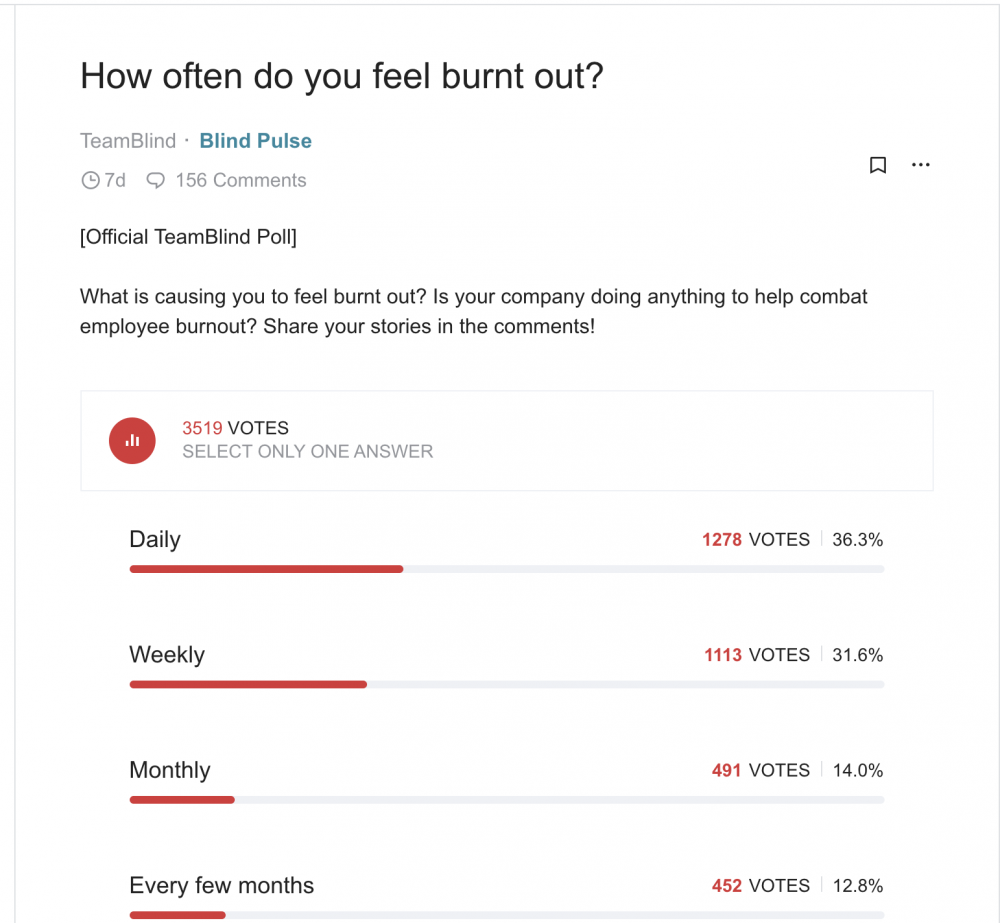Blind Pulse: Frequency Of The Burnout
Burnout is becoming a more common workplace experience as an increasing number of professionals remain isolated from coworkers, friends, and loved ones. On Blind, an anonymous professional network, with 3.6M verified users, we ran a poll asking, “How often do you feel burnt out?”
The poll had 3,500 responses and robust dialogue with 156 professionals commenting on their own experiences, here are some key learnings:
- 36% of professionals say they feel burnt out daily
- Only 5% of Professionals say they never feel burnt out
- Oracle, Apple and Google are among the companies whose employees are least burnt out daily
A user at Amazon responded to the poll saying, “With the pandemic going on and wfh extended, I start to see little direction in my future. What’s the point of my TC or prospective promotion when there’s nothing other than work going on in my life.”
You can download a full report Here.
You can see the raw data highlighting the overall responses, most and least burnt out companies here.
Another user at LinkedIn states “Long work hours is causing me to burn out. It’s a common habit within my team to overwork and it stems from the top. I don’t see any solution other than to switch teams or move to another company.” Professionals on Blind are bringing the conversation to light and helping us understand the root causes of burnout.

How frequently professionals feel burnt out has layers. This past February, a Blind survey concluded that nearly 61 percent of professionals are burnt-out. We asked the same questions again this week to see how mental health in the workplace is evolving throughout a pandemic.
Blind ran these exact three questions before COVID-19 became relevant in American life (2/16 – 2/24), and asked them again the first week of May:
Q1. Are you experiencing burnout at your company?
Q2. What is the main cause of employee burnout at your current workplace?
Q3. What business unit do you work in?
KEY FINDINGS (4/30-5/04) 6,789 responses:
- 61% of professionals were burnt out in February, that number has risen to 73%
- In COVID-19 economy, one in five of professionals are burnt out by their fear of job security (19%)
- 20.5% of professionals in a COVID-19 workforce feel they have an unmanageable workload
- Over 10% of professionals feel as if they have no control over their work
- 88% of Lyft professionals are burnt out- making them the most burnt-out company within our study
- All surveyed companies have at least 60% of their workforce burnout (pre-COVID-19 the minimum was 30%)
With such a positive movement towards destigmatizing mental health and the conversations about permanent changes to work for the foreseeable future, burnout should now be included in the forefront of the conversation. The survey results are troubling, but not altogether surprising. Burnout has risen by 12% due to COVID-19 in four weeks. The burnout conversation has never been linear; the health implications include anxiety, insomnia, depression, substance abuse, and coronary heart disease. Mental health is becoming a more significant national concern as more Americans are forced to remain isolated away from loved ones and support systems. Prior to this study, we wanted to gauge the platform’s emotional well being in terms of their anxiety levels, feelings of loneliness, and productivity during social distancing. 56.4% of professionals are experiencing increased feelings of anxiety during work from home and social distancing. Another 52.9% of professionals are experiencing increased loneliness during work from home and social distancing. These statistics have stories and a human cost behind them. An anonymous professional at Cisco states, “Most of the folks have now spent enough time to digest what social distancing means. Now that reality is accepted, we need creative ways to occupy yourself.” These statistics and trends were foreshadowing the sharp increase in burnout.
To add another layer, burnout can feel personal. According to our survey, the top reasons for burnout range from a fear of job security, unmanaged workload, and lack of managerial support. What can c-level leaders do to address a personal issue systematically, in a time where they cannot even have in-person interaction with them? What do leaders who are considering taking their companies remote permanently need to know? After seeing the data, we believe that those answers are found in what is mainly causing burnout.